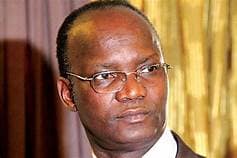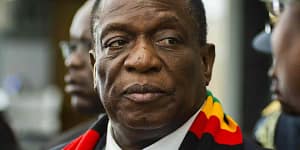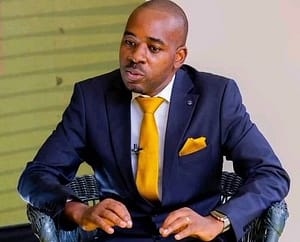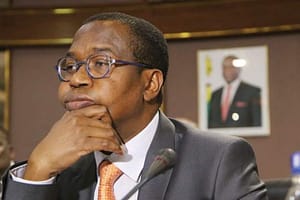MDC aided the real devil to get rid of a walking dead man

Jonathan Moyo
By Prof. Jonathan Moyo
EMMERSON MNANGAGWA completes three tumultuous years at State House on 24 November 2020, as President of Zimbabwe, having been sworn into the office backed by tanks and bullets on the same date in 2017 following a military coup, dubbed “Operation Restore Legacy”, that deposed former and late President Robert Mugabe.
Against this backdrop, it is propitious to unpack how the military’s Operation Restore Legacy coup has fared in terms of the situation of state politics in Zimbabwe today and to map its trajectory beyond the horizon. In this connection, it is important to recall the following seven demands that the military made on 16 November 2017 to President Mugabe through the then Commander of the Zimbabwe Defence Forces, General Constantino Chiwenga:
SEVEN DEMANDS OF OPERATION RESTORE LEGACY
Politicians stop reckless utterances against the military which are causing alarm and despondency within the rank and file which may result in anarchy thereby threatening peace and security in the country.
The Party to afford every Party member a fair and equal chance of being heard or elected and the whole democratic process to be observed from the cell up and no imposition of candidates.
Cease all purging in the Party and Government and reunite the Party by reinstating all previous victims.
Implement the recommendations of the War Veterans Indaba and reintegrate all war veterans into the mainstream of the Party and Government.
The known counterrevolutionary elements who have fomented the current instability in the Party be weeded out both in the Party and Government.
Security of tenure of employment as it relates to the provisions of the current Constitution of Zimbabwe.
A clear-cut roadmap for succession in the Party including a fresh start and going for a new election in 2018.
These seven demands define what Operation Restore Legacy was all about and are thus the only realistic, and indeed objective basis, for assessing where things are today and their likely direction in the foreseeable future. But before using the seven demands as a template for assessing where things are today, some key observations on what “Operation Restore Legacy” was all about.
THE ESSENCE OF OPERATION LEGACY DEMANDS
First, the demands which defined the essence of Operation Restore Legacy were made to President Mugabe on 16 November 2017, two days before the “Mugabe Must Go” march of 18 November 2017, which some in the opposition called “a miracle”, while others said it was “freedom day”. This is notable because none of the seven points raised by General Chiwenga included a demand for Mugabe to go, which demand was the purported raison d’etre of the 18 November 2017 march.
Second, none of the seven demands was national in content or character; in other words, there was nothing about Operation Restore Legacy which spoke to or addressed constitutional concerns, national development issues or the state of the economy. Five demands were about Zanu PF and two were about the military; there was absolutely nothing about Zimbabwe or Zimbabweans. This means there was nothing that reflected the public concerns or an agenda of the opposition; yet it was the opposition, civil society and even some churches that were at the forefront of mobilising the 18 March 2017, “Mugabe Must Go” march at the best of the military.
Third, the fact that Operation Restore Legacy happened seven months before the general election due in July 2018 meant that the operation was intended to render that election redundant; yet the opposition, civil society and some churches that supported the military coup either did not see or understand the impact of the operation on the general election. By seeking to render the July 2018 election redundant before the fact, military coup not only overthrew the new 2013 Constitution, but it also usurped, in advance, the will of the people.
Fourth and most important, as a military coup, Operation Restore Legacy transformed Zimbabwe from a de facto one-party state under Zanu PF into a de facto military state under the Zimbabwe Defence Forces. So, in real terms, Zimbabwe today is a military state with an effectively suspended Constitution.
THE PRE-COUP OPERATION RESTORE LEGACY COALITION
An untold but significant feature of the November 2017military coup is the makeup of the Operation Restore Legacy coalition. While the roles played in particular by Britain, China and South Africa, jointly and severally, are now common cause; little has been said about how, on the national front, coup makers took advantage of what had become a widespread “Mugabe must go” sentiment, to build an Operation Restore Legacy coalition that brought on board pretty much the entire opposition, certainly the MDC formations; key civil society groups and even churches, whose involvement was highlighted by the key role in the coup played by the Catholic Church’s Father Fidelis Mukonori, who ended up being the lead emissary of the commanders of the Zimbabwe Defences to President Mugabe.
An issue that is yet to be unpacked is who was who and who did what from the opposition ranks in support of Operation Restore Legacy. Money and other trinkets changed hands, big time. But that is a story for another occasion. A number of key opposition leaders, as well as opposition mouthpieces that supported the coup, have been either silent or are in hiding with their heads in shame about their support for the military coup. But the chickens are bound to come to roost, sooner or later.
THE POST-COUP OPERATION LEGACY COALITION
Following the 2018 general election, whose outcome was a foregone conclusion as a direct consequence of the coup, the disintegration of the pre-coup Operation Restore Legacy coalition, which had started soon after Mnangagwa’s swearing-in on 24 November 2017 when he did not put together a GNU cabinet, became more pronounced on the back of a stolen presidential election. After the 2018 general election, Mnangagwa and his henchmen had expected Nelson Chamisa and his MDC-A, who had been an important part of the Operation Restore Legacy coalition, to constitute themselves into a loyal and friendly opposition. The refrain was that Chamisa is young and, even if he won, he needed to defer to Mnangagwa and wait for his turn in 10 or so years.
The Zanu PF government, prompted by securocrats in the Joint Operations Command (JOC), especially from the CIO, had hatched a co-optation plan to amend the 2013 Constitution to establish the Office of the Leader of the Opposition, sweetened with trinkets as perks. Buoyed by his stolen victory in the 2018 presidential election, which exposed him to sweeping support in the electorate, Chamisa turned down the offer of the position of Leader of the Opposition in Parliament, which would have been specially created for him as a Constitutional Amendment. This did not go down well with Mnangagwa and his CIO-led securocrats who felt that, by snubbing Mnangagwa, Chamisa was dishonouring the “Chunhu Chedu” caliphate, which they presumed to be the glue of the Operation Restore Legacy coalition.
In the circumstances, the CIO-led Mnangagwa caliphate came up with Plan B and crafted a post-coup Operation Restore Legacy. The plan was based on grouping some 17 or so briefcase political parties that the CIO had in fact sponsored to contest the 2018 general election to give the false impression that democracy was alive and well in Zimbabwe, after Mugabe who was never challenged by that many candidates in his 37-year reign. The grouping was done under an umbrella christened as the Political Actors Dialogue (POLAD) platform, reminiscent of Ian Douglas Smith’s Internal Settlement that grouped Bishop Abel Muzorewa, Rev Ndabaningi Sithole, Chief Jeremiah Chirau and Chief Kaiser Ndiweni as black Rhodesian sell-outs who were prepared to the front for Rhodie interests to the detriment of Zimbabweans.
POLAD, like the divisive Rhodesian Internal Settlement, widened and deepened divisions not only within opposition ranks but also between Mnangagwa’s CIO-led camp and commanders in the Zimbabwe Defence Forces, whose understanding of and commitment to Operation Restore Legacy was based, as it still is, on the seven demands that General Chiwenga presented to President Mugabe on 16 November 2017.
OPPOSITION IN OPPOSITION OF ITSELF
A major dynamic and consequence of the post-coup Operation Restore legacy coalition are that the opposition has strangely been preoccupied with opposing itself. The politics of self-opposition within the opposition have centred on and around the battle to succeed the late MDC leader, Morgan Tsvangirai, and has largely pitted Chamisa against Thokozani Khupe who has enjoyed the largesse of the CIO; as well as the political cover of the trio of MDC sell-out heavyweights: Douglas Mwonzora, Morgen Komichi and Elias Mudzuri.
To the CIO, which is bidding for Mnangagwa as the organisation’s founding political leader following Zimbabwe’s independence in 1980, the internecine battle to succeed Tsvangirai within MDC formations has been a God sent opportunity which has gifted Mnangagwa, who politically unpopular especially within Zanu PF, lots of room to make political mischief. It is against this background, that the CIO went for broke against the MDC by combining forces with Kuda Tagwirei, the Sakunda boss who was ubiquitous with a purse stashed with a slush fund from illicit proceeds of command agriculture and other assets stripped from the state until the US stopped him dead in his tracks by putting him under the so-called targeted sanctions.
The result was an astonishing blow against the MDC. First, there was a dubious Supreme Court judgment which inexplicably nullified Chamisa’s leadership of the MDC-Alliance by ordering that the MDC formation that was previously led by Tsvangirai should go back to its 2014 structures and hold a congress to choose a new leader to succeed Tsvangirai. In making this incredulous if the not ridiculous judgment, while conceding that literally everything, not just water, had gone under the bridge, the Supreme Court found that it was necessary to construct a new bridge in the ostensible interest of promoting and ensuring democratic governance in and among Zimbabwean political parties.
As if this was not bad enough, with the CIO pulling the strings and encouraged by the MDC-A’s lack of a visible or viable legal or political response, the Supreme Court’s judgment to nullify Chamisa’s leadership of the MDC-A was abused to effect unprecedented recalls of his MPs from Parliament, with the consequence of leaving him politically impotent as the
MDC-A became a political carcass. The executive, judicial and legislative bodies ominously converged to ruthlessly dismember the body politic without checks and balances, and thus with shocking impunity and devastating consequences.
The fact that Chamisa and the MDC-A have had no response whatsoever to this unprecedented development has exposed them as bereft of political strategy and has left their social base bewildered and scattered beyond description. What is particularly dangerous about this situation, with far-reaching implications for constitutional democracy in Zimbabwe, is that the target is the right to vote and the victim is the voter.
NOVEMBER 2020: THE REAL OPPOSITION REMAINS WITHIN THE SYSTEM
In the run-up to Operation Restore Legacy in November 2017, the opposition ranks were silent and inactive. The MDC-T, with an ailing Tsvangirai, was at its weakest since from August 2013 to November 2017. Politically, the opposition was conspicuous by its absence. The contest for political or state power was within the system: then it was Lacoste versus G40. The presumption at the time was that Lacoste was the opposition; and because it was presumed to be aligned to President Mugabe, G40 was taken as the ruling clique or faction.
It was unfortunate but not surprising that the MDC-T under Tsvangirai supported the opposition within Zanu PF and joined hands with the Lacoste caliphate to be a willing and enthusiastic part of the post-coup Operation Restore Legacy coalition. It was not surprising because Lacoste had become the real opposition, in place or instead of the MDC-T, which should have been the opposition. Conversely, this was unfortunate because, by joining hands with Lacoste which was embedded in the military, the MDC-T became part of a military coup which overthrew the very Constitution that many thoughts had been a founding objective of Tsvangirai’s party since its formation in 1999. It was ahistorical and embarrassing to see the MDC-T opposing its own reform achievement, in the form of the new 2013 Constitution, by recklessly and incomprehensibly supporting a military coup whose essence was the overthrow of a new and democratic Constitution, which was hardly four years old, under the guise of showing Mugabe the door when in fact Mugabe was already facing his maker with little time left for him in this world of sin after 37 years in power. The idea of staging a military coup to remove a dead man walking, while retaining the entire 37-year old securocratic system of violence and oppression and calling the farce a new dispensation and second republic was—as it still is—beyond belief.
What is instructive is that three years after Operation Restore Legacy, the real opposition remains within the system. While the opposition is caught in a Hobbesian state of nature where everyone in the opposition is against everyone in the opposition as mahumbwe continue to be the order of opposition politics in Zimbabwe, the real opposition in 2020 remains within the system.
The tables have turned with the 2017 ruling clique being the 2020 internal opposition to the 2017 internal opposition which is now the 2020 ruling clique. In other words, G40 within Zanu PF is today’s opposition to the “Chunhu Chedu” caliphate which came into power through a military coup in 2017.
The historic question facing today’s G40 inside Zanu PF, three years after Operation Restore Legacy, is whether it will behave like Lacoste did in 2017 and seek to grab power internally as a Zanu PF affair; or it will rise to the historic call of the silent majority in Zanu PF that did not support Operation Restore Legacy in 2017, who most definitely were not part of the 18 November 2017 march against Mugabe, and join hands with the generality of Zimbabweans who are clamouring for a genuine revolution whose first step is for Zanu PF to go.
Parenthetically, it is important to underscore that a revolution is about principles, not principals who call themselves stockholders or whatever. A revolution should be about transforming society; it should be inclusive and therefore should be by, about and for everyone. A revolution does not discard the past, it transformationally rights the wrongs of the past to make a good society today with even better prospects for tomorrow.
Three years after Operation Restore Legacy, the writing is on the wall that the military coup was only a Zanu PF affair with nothing for the people of Zimbabwe. In fact, the livelihoods and lives of Zimbabweans have been threatened and ravaged by Operation Restore Legacy. In economic terms, Zimbabweans are worse off today than they were in November 2017. The real impact of the coronavirus is yet to be felt in Zimbabwe, with catastrophic public health consequences. Operation Restore Legacy has seen Mnangagwa’s gukurahundisation of the state, with some 117 abductions and torture of targeted citizens since November 2017; not to mention the broad daylight murder of fleeing civilians in Harare’s CBD on 1 August 2018 and the murder, torture and rape of urban residents, especially but not only in Harare and Bulawayo, between 14 and 28 January 2019. Under Operation Restore Legacy, Zimbabwe has not only been a humanitarian disaster, it also has been a human rights nightmare.
Thus, Operation Restore Legacy has proven to be a farce in Zimbabwe’s history. It is going nowhere and has no future. The seven demands that the military made to President Mugabe on 16 November 2017 have not been realised or settled within the system or Zanu PF. Mnangagwa has resisted those demands and pushed back on the reasons that the military used to justify Operation Restore Legacy. For example, it had been agreed that Zanu PF regalia would not have the portrait of the party’s president and first secretary as used to happen in the Mugabe years but Mnangagwa and his “Chunhu Chedu” clansmen have insisted on doing everything the Mugabe way; they boast that, “if Mugabe did it, why should we not did it also”. So, there is a deadly stalemate pitting Mnangagwa against the military.
After 40 years of Zanu PF misrule littered with failed internal attempts to reform the party, it is no longer a matter of a political argument or a matter of freedom of association but a matter of historic necessity that Zanu PF has become like an old and now useless family car which, while loved by many in the family with fond memories of an occasionally glorious past, the car must now be taken to a scrapyard and replaced with a new, bigger and better family car for every family member to have comfortable space in it, as a celebration of the values and virtues of driving; balanced with the appreciation of the utility of and need for an effective and efficient brand new car.
–Professor Jonathan Moyo is a former cabinet Minister under President Mugabe’s administration.






